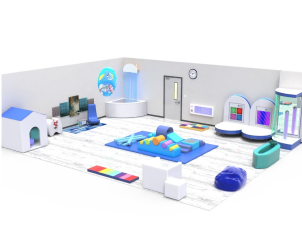It’s time to transition to the structured routines of the school year again. This can come with many challenges for kids, so it’s important to find sensory-smart strategies to support your family in the new school year. Our occupational therapists are sharing their go-to strategies to ease the transition.
1. Dress for Success:
Wearing comfortable clothing can make a huge difference in a child’s comfort and focus. A calming compression shirt can be worn alone, under a vest or under a school uniform. Choose a Weighted Compression Vest during particularly stressful times or in intervals. If your school dress code does not allow hats, then a Weighted Cap can be great for the transition to and from school.
2. Take Sensory Breaks:
Meet with your child’s teacher ahead of time to discuss what setup there is for sensory breaks. Suggest a Break Box for the classroom and go over some sensory room education. Working with the teacher to ensure the proper tools and signals for taking a sensory break are in place will make the school day go smoother for your child.
3. Stick to Routines:
Take a look at your morning and afternoon routines. A bit of active movement either before getting in the car or on the bus might be beneficial for your child. Time on a trampoline or swing can be a good option. If they need calming input then use a foam roller or brushing protocol. Work this sensory time into your routines.
4. Electronic Slow Down:
Try scheduling screen time if you see that they make transitions harder for your child. Similarly to sensory time, work this into your routines so that it is not making your child’s transition harder.
5. Food for Brain Power:
If you send lunch or snacks for your child, consider sensory food options. Crunchy and chewy foods, such as celery, apples and carrot sticks provide good nutrients as well as oral stimulation. This can boost kids’ focus and attention in class.
6. Look for adaptive School Supplies:
Aside from the typical supply list of pencils, notebooks and folders, your child may benefit from sensory supplies. Tools such as adaptive paper, pencil grips and seat cushions provide a variety of sensory input to increase focus.
7. Have Practice Runs:
Boost your child’s confidence on the first day by performing trial school days. Designate “work time” during the afternoon for reading, writing, math or other subjects. If your child is attending a new school, see if you can go together to tour the school and map out the most important areas.
8. Create a Visual Schedule:
Seeing your schedule laid out can help kids know what is coming next, reducing stress. Put it up on the wall so that everyone in your family can see it. Set up a morning station for backpacks, lunch, homework and other supplies are kept to avoid any more stress in the morning before school.
9. Check in regularly:
This time of year is exciting and stressful, so make sure to check in regularly with both your child and their teacher. Discuss what is and is not working. Then make a plan for moving forward.
Settling into a new routine takes time. We hope that these tips help your child transition smoothly to the new school year. What are your best tips? Let us know in the comments!
This post was originally posted on 08/25/2019 by . It was updated for accuracy and comprehensiveness on 07/28/2022.

























Comments